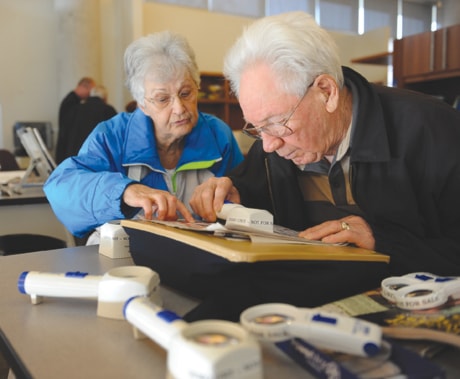TORONTO — You don’t have to be blind to see the value of this place.
From plastic doodads that keep your socks together in the wash, to electronic wands that identify your CDs or food, a new Toronto store that caters to the visually impaired has more than 200 items to help people navigate a darkened world.
“We’ve got things here that enhance your vision, or replace your vision,” says Geoff FitzGibbon, director of business operations for the CNIB, which runs the outlet at its Toronto headquarters.
“And we’ve got a whole host of everyday useful items for when you’re home or out and about, which just give you an extra edge,” he says.
The institute operated a number of stores across Canada in decades past, but closed them in favour of mail order and web-based businesses. “But there are some people who need to see the products, who need to see them and try them. We heard that and we responded.”
While the new Toronto flagship store marked its grand opening last month, the CNIB will have 18 outlets across Canada by year’s end.
There are the obvious standbys that are signature staples of a visually impaired life.
“There are some things you’d say, ’Of course’ — things like magnifiers, special sunglasses, white canes,” he says. “But then there’s other stuff you might not even know exists and other stuff you might say, ’Why would you have that?”’
Products at the store generally fall into three categories. There are products that speak what other people see, items that magnify images for those with some sight, and items that make it easier for the blind to feel their way through everyday activities.
Among the speaking selection, there are talking clocks and dozens of styles of talking watches.
There are talking book players, talking thermometers, talking and beeping cookware and talking scales, of both the bathroom and kitchen variety.
Then there’s the wand, which has revolutionized life in the blind community since an affordable “Pen Friend” version was introduced a few years ago.
The $150 wand, about the size of a big cigar, comes with dozens of small circular labels that you affix to any item you need identified.
Each time owners place a coded label on an item they or a helper can scan it with the wand, and then make a voice recording into the device identifying the product and any instructions it may include.
When the wand subsequently scans that label, it will select and replay the recording.
“That is on my holiday (wish) list this year for sure,” says Debbie Williams, 39, who suffers from retinitis pigmentosa and has only limited tunnel vision.
“I don’t know how many times I’ve opened a tin of food and said, ‘Oh, that’s not really what I wanted.’ Now if I want tomato soup, I get tomato soup.”
Williams also owns 500 music CDs and is constantly asking her partner which one she has pulled out. “I just won’t have to bug him saying, ’What do I have here’ every time.”
Williams already owns one of the store’s offerings: a colour detector you can scan over clothes to match them correctly. “No blue and green for me,” she says. “Yuck.”
Among the visual aids for those with residual sight are computer mouse-like mechanisms that can scan print and magnify it on a screen.
There is even, for $40, a giant magnifying glass to place over a television or computer screen.
Items that offer tactile help include plastic templates that go over envelopes to correctly locate the address position and a host of board games that include pieces identified by Braille lettering or shape.
“Just because you’re blind doesn’t mean you don’t want to play,” FitzGibbon says.
FitzGibbon admits it may sound odd a store for the blind would offer its customers a chance to “see” their purchases before they buy.
“’See’ is an interesting word — when you and I talk about ’see,’ we mean our eyes,” he says.
“Blind people often say they ’see’ things, but they’re using their hands and so forth. They’re perceiving just the same.”
In Ontario, the ministry of health will subsidize the purchases of many of the items sold in the store, FitzGibbon says.
